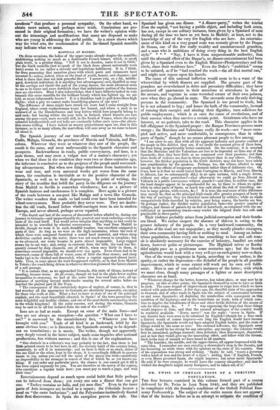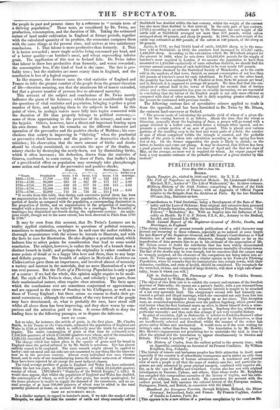DR. TWISS ON CERTAIN TESTS OF A THRIVING POPULATION.
THE four lectures contained in this volume formed part of a course delivered by Dr. Twigs in Lent Term 1845, and they are published in compliance with the founder's conditions of the Oxford Political Eco- nomy Professorsifp. The subject of the entire coarse does not appear ; that of the lectures before us is an attempt to estimate the condition of
the people in past and present times by a reference to " certain tests of a thriving population." These tests, as considered by Dr. Twiss, arc production, consumption, and the duration of ,life. Taking the estimated extent of land under cultivation in England at former periods, together with the calculated quantity of its produce, the economist compares them with the same things at the present time, and arrives at two satisfactory Conclusions. 1. That labour is more productive than formerly. 2. That it is better rewarded ; more staple articles being consumed per head, and of a better quality—as butcher's meat, and wheat superseding inferior grain. The application of this test to Ireland fails. Dr. Twigs infers that labour is there less productive than formerly, and worse rewarded ; the consumption less, if the kind of food is the same. The fact is pro- bably true ; but the statistics are more scanty than in England, and the conclusion is less of a logical sequence.
In like manner, the lecturer uses the vital statistics of England and France to infer the greater comfort of the people from the greater duration of life—duration meaning, not that the maximum life of man is extended, but that a greater number of persons live to advanced maturity.
This account of the subject and conclusions of Dr. Twigs merely indicates the germ of his lectures; which discuss at considerable length the questions of vital statistics and population, bringing together a great number of facts, and applying them to the subjects in hand. In this point of view, he perhaps enters more fully into topics connected with the duration of life than properly belongs to political economy,— some of them appertaining to the province of the actuary, and some to the hygeist. Others, however, have a direct and important bearing upon his own theme. Such are his remarks on the different character and operation of the preventive and the positive checks of Malthus ; his con- clusions that society is improving in " thriving " when the prudential or preventive check increases and the positive or destructive check di- minishes ; his observation that the mere amount of births and deaths should be closely scrutinized, to ascertain the ages of the deaths, as misery checks by destroying the newly-born, not by diminishing births, which it often increases ; his deduction, drawn from the statistics of Geneva, confirmed, to some extent, by those of Paris, that Sadler's idea of a providential effect on population may seemingly take place,through some action and reaction of the preventive and positive checks.
Deaths. Births. Marriages. Ratio or births to a "Years. Population mean. 1 in mean. 1 in mean. 1 in marriage.
1695-1710 17,700 623 28 ... 646 27 ... 132 134 ... 4.88 1711-1730 20,000 635 31 ... 667 30 ... 171 117 ... 3.90 1781-1750 21,500 649 33... 677 31 ... 186 115 ... 3.63
1751-1770 23,500 691 34 ... 781 30 ... 2130)114 ... 3.62
1771-1790 25,000 741 34 ... 756 33 ... 211
"It results from this table that during each successive pen there has been
th
an augmentation in the total of the population, a diminution in the pro- porton of deaths as compared with the populaticab, a corresponding diminution in the proportion of births,. and an augmentation in the proportion of marriages, coupled with a decrease in the ratio of births to a marriage. The fecundity of Marruiges has diminished one-fourth during the eighteenth century.. An analo- gous result, though not to the same extent, has been observed in Paris from 1700 to 1790."
It may be seen from this account, that Dr. Twiss's Lectures are in reality, applied statistics, sometimes to questions of political economy, sometimes to mathematics, or hygiene. In each case the author exhibits a thorough acquaintance with the science he intends to illustrate, and with the facts he uses for illustration. He also displays a practical mind, which induces him to select points for consideration that lead to some useful conclusion. The subject, however, is rather the branch of a branch than a distinct branch in itself; and perhaps the originality is rather confined to some points of detail or to a happy idea here and there, than to any large and definite purpose. The breadth of subject in Merivale's Lectures on Colonization gave them an importance, and involved almost of necessity a variety and interest in the materials, that no mere illustration of a view can ever possess. But the Tests of a hriving Population is only a part of a course: if we had the whole, this opinion might require to be modi- fted. The style of Dr. Twiss is clear, close, and scholarly ; but parts, from their mathematical nature, often require close attention. The facts upon which the conclusions rest are sometimes conjectural or approximate; and are opposed to the views of Southey in his Colloquies, as well as to those of Young England : but there seems no reason to doubt their ge- neral correctness ; although the condition of the very lowest of the people may have deteriorated, or, what is probably the case, have stood still whilst all above them has been improving, and they show worse by com- parison and the attention paid to them. It seems difficult to deny the leading facts in the following passages, or to dispute the inference.
TEST BY CORN.
Let us take, for instance, the article of grain, in the first place. Mr. Charles Smith, in his Tracts on the Corn-trade, estimated the population of England and Wales in 1760 at 6,000,000, which is sufficiently near the truth for our present inquiry. The entire consumption of grain at that time he estimated to be 7,550,350 quarters; of which 3,750,000 quarters were wheat, and of the remainder, 1,026,125 consisted of barley, 999,1)00 of rye, and 1,791,225 of oats. The change which has taken place in the species of grain used for bread in England since the period referred to by Mr. Smith is notonous. Rye has almost entirely ceased to be employed. The same remark might almost be applied to barley; and oat-meal and oat-cake are not consumed to any thing like the same ex- tent as in the previous century. Almost every individual now uses wheaten bread; and in some of our manufacturing towns the inferior sorts even of wheaten flour have been rejected by all except the moat indigent claszeg The total average produce of gram in England and Wales has been estimated, within the last ten years, at 29,450,000 quarters; of which 12,450,000 quarters consist of wheat. (M'Culloch'a "Statistics of the British Empire," 1. 529.) It would thus appear, that whilst the population of England and Wales has doubled, the consumption of wheat, as well as of other grain, has nearly quadrupled; for the home producer is unable to supply the 'demand of the consumers, and an an- nual average of at least 500,000 quarters of wheat may be added to the total quantity produced at home, on account of foreign importations.
TEST BY BUTCHER'S MEAT.
In a fibula, manner, in regard to butcher's meat, if we take the market of the Metropolis, we shall find that the number of cattle and sheep annually sold at Smithfield has doubled within the last century, whilst the weight of the carcass has also more than doubled in that interval. In the early part of last century, (1710,) according to an estimate made by Dr. Davenant, the nett weight of the cattle sold at Smithfield averaged not more than 370 pounds, whilst calves averaged about 50 pounds, and sheep 28 pounds. In 1800, the nett weight of the cattle was estimated at 800 pounds, of the calves at 140 pounds, of the sheep at 80 pounds.
Again, in 1742, we find 79,601 head of cattle, 503,260 sheep, to be the num- bers sold at Smithfield; in 1842, the numbers had increased to 175,347 cattle, 1,438,960 sheep. According to the calculation which Mr. M'Culloch adopted for the amount in 1880, when he sets down 154,434,850 pounds for the supply of butcher's meat required in London, if we assume the population to have then amounted to 1,450,000 exclusively of some suburban districts, we should find the average annual consumption of each individual to be very nearly 107 pounds. The returns obtained by the Statistical Society of Manchester, as to the cattle sold in the markets of that town, furnish an annual consumption of not less than 105 pounds of butcher's meat for each inhabitant. In Paris, on the other hand, the quantity has been estimated by M. Chabrol at from 85 to 86 pounds per head; and in Brussels it is suppa.ed to average 89 pounds. We thus find that the con- sumption of animal food in the towns of England far exceeds that of foreign cities; and as this consumption has gone on steadily increasing, we are warranted in concluding that the labour of the English people is not only more efficient as compared with that of other nations, but is daily acquiring greater efficiency, if the present be contrasted with previous results. The following curious fact of speculative science applied to trade is from the appendix, and has been furnished to Dr. Twiss by Mr. Dixon, the eminent land-surveyor at Oxford. " The present mode of calculating the probable yield of wheat of a given dis- trict for the coming harvest is as follows. About the time that the wheat is blooming, generally about the beginning of June, a person will go round with a gauge secreted in a hollow cane, which forms a triangle when opened, and re- presents a certain portion of an acre of ground. This is placed over various portions of the standing crop in the best and worst parts of a field: the number of ears of wheat comprised within the triangle is counted, and the probable quality of the grain is taken into calculation according as the spring has been wet or dry. On the former supposition the grain is likely to shrink; on the latter, to harden and come out plump. It may be observed, that if there lice been a good general rain during the last ten days of April and the first ten days of May, on the average, no more wet is required for wheat. An expert gauger will form a very accurate estimate of the probable produce of a given district by this method."



























 Previous page
Previous page